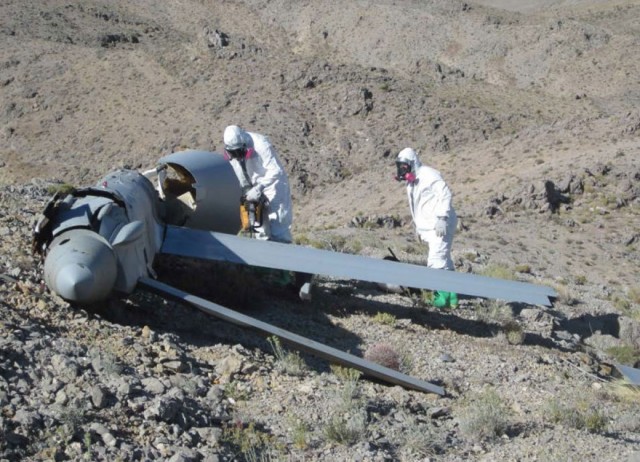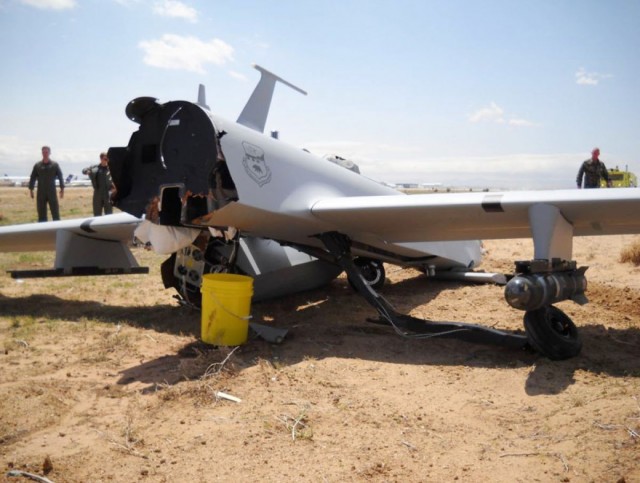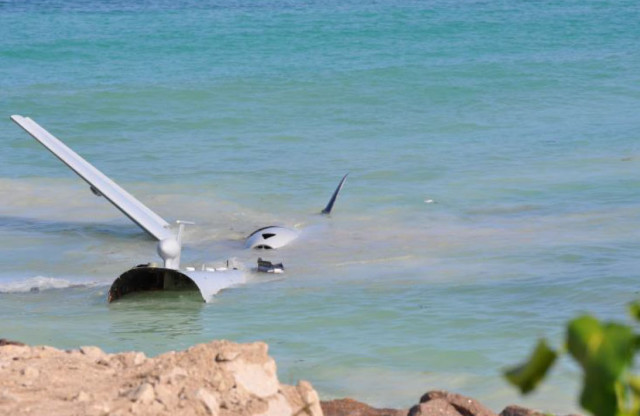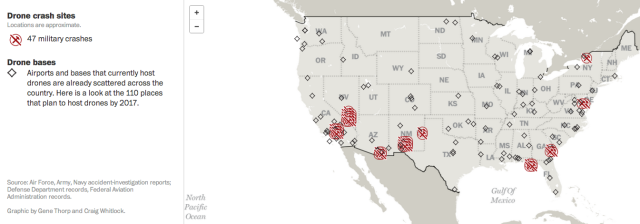Shortly after the day’s final bell rang and hundreds of youngsters ran outside Lickdale Elementary School with their book bags and lunch-boxes, a military drone fell from the sky. The 375-pound Shadow reconnaissance drone skimmed the treetops as it hurtled toward the school in Jonestown, Pa. It barely missed the building, then cartwheeled through the butterfly garden and past the playground. The aircraft kept rolling like a tumbleweed and collided with a passing car on Fisher Avenue. People called 911. The rescue squad arrived in a hurry. Luckily, no one was hurt.
The April 3 near-disaster was the latest known mishap involving a military drone in the United States. Most U.S. military drone accidents have occurred abroad, but at least 49 large drones have crashed during test or training flights near domestic bases since 2001, according to a yearlong Washington Post investigation.
 Air Force personnel inspect the wreckage of a Predator drone that crashed during a training flight in May 2013 near Creech Air Force Base in Nevada. (U.S. Air Force)
Air Force personnel inspect the wreckage of a Predator drone that crashed during a training flight in May 2013 near Creech Air Force Base in Nevada. (U.S. Air Force)
A 63-foot-long QF-4 target drone exploded into a fireball at Tyndall Air Force Base in Florida on July 17, forcing authorities to close a nearby highway. A Global Hawk, the largest drone in the military’s fleet, crashed on Maryland’s Eastern Shore in June 2012. Two years earlier, the military almost had to shoot down a runaway Navy drone after it penetrated some of the most guarded airspace in the country, over Washington, D.C.
The number of accidents has jumped as the military has brought back drones from overseas and operated them more frequently in airspace shared with civilian planes. The military has almost tripled the number of hours its drones have flown annually in shared U.S. airspace since 2011, according to federal data.
Now, the military and the federal government are preparing for a far bigger expansion of drone flights that will transform U.S. aviation — but could also pose the biggest challenge to safe air travel in decades.
Thanks in part to a new federal law that will open the national airspace to drones of all kinds, the Pentagon is planning to operate thousands of drones from at least 110 bases in 39 states, plus Guam and Puerto Rico, by 2017.
Budget documents show the military has spent or allocated $1.6 billion for drone-related construction projects in the United States. The Defense Department has about 10,000 drones worldwide, from one-pound Wasps and four-pound Ravens to the 15-ton Global Hawk.
At the same time, under orders from Congress, the Federal Aviation Administration is preparing rules that will allow civilian drone flights across much of the country. The agency predicts that as many as 7,500 small commercial drones could take to the skies by 2018.
American airspace is safer than ever. Fatal accidents involving passenger carriers have become exceedingly rare. Military and FAA officials pledge that standards will not be compromised to accommodate drones. The Pentagon says that accident rates per flight hour have declined steadily since it began deploying drones to war zones in the early 2000s and that it takes extra precautions when flying at home.
Air Force Col. James Marshall, safety director for the Air Combat Command, said the military has trained regular pilots for generations in the United States, with relatively few accidents, and that flying drones at home will be no different.
“We’re really big into risk management,” he said. “I’m comfortable with what I see with the mitigation approach that we’re taking.”
Michael P. Huerta, the FAA’s administrator, said the agency would integrate drones into the national airspace in stages and only after a careful review of each step.
“We have an extraordinarily safe aviation system, and that’s been through the hard work of a lot of people in industry and their public-sector counterparts to continually raise the bar on safety,” he said in an interview. “As we integrate unmanned aircraft into the national airspace system, I believe that the public expect us not only to maintain but to continue to enhance the levels of safety that we’ve been able to achieve for conventional aircraft.”
But thousands of pages of military investigative reports, obtained by The Post under the Freedom of Information Act, show a pattern of pilot errors and mechanical failures that have caused drones to crash in the United States again and again — including drones flying in civilian airspace.
The documents also reveal that some military personnel harbour an ingrained distrust of the flying robots.
After a Predator wrecked at Cannon Air Force Base in New Mexico on July 28, 2010, an unidentified instructor pilot told investigators that commanders had been queasy about having remotely controlled aircraft on the base, fearful that they might crash into buildings.
“The problem is that nobody is comfortable with Predator. Nobody,” the pilot said, according to an interview transcript. He called the malfunction-prone drone “the most back-assedward aircraft I ever flown.”
Scattered opposition to drones has built across the country in the form of protests and campaigns to stop drone strikes overseas or prohibit surveillance by government aircraft.
As crashes gradually pile up, however, some anti-drone groups are recognizing that the planes could also pose a lethal threat at home through accidents.
On Nov. 12, an advanced Reaper drone operated from Hancock Field, an Air National Guard base near Syracuse, N.Y., crashed into Lake Ontario. A few parts washed up on shore, but the Air Force never found the aircraft, which has a 66-foot wingspan, and has not explained what happened.
Ed Kinane, a peace activist from Syracuse and member of a group called Upstate Drone Action, called the crash “a wake-up call.” The Air Force has permission from the FAA to fly Reapers over Syracuse, as well as large stretches of airspace north of the New York State Thruway. “To me, it’s appalling that they’re flying them over urban areas,” Kinane said. “The Pentagon has been so eager to get their hands on drones, and more drones, that they’re not as good as they should be.”
The manufacturer of the Reaper and the Predator is General Atomics Aeronautical Systems, the leading producer of large U.S. military drones. Frank W. Pace, the company’s president for aircraft systems, said the Reaper “certainly is” safe to fly in the United States. He was more cautious about the Predator, an older aircraft that the firm stopped making in 2011.
The Predator was a pioneer on the battlefield. It was designed to be cheap and lightweight, he said, with reliability and longevity as lesser priorities. Over the years, General Atomics has upgraded parts of the aircraft to make it safer. But Pace said he would not recommend flying the Predator over towns or cities in the United States.
“You really want to be flying it over areas that aren’t highly populated,” he said. “As a citizen, I wouldn’t want it to happen.”
The Air Force has 150 Predators, many based overseas. In the United States, Air Force officials said, Predators are generally flown only in military airspace. Still, demand is building to move them around for other purposes.
Last August, for instance, the California Air National Guard sent a Predator on a 300-mile journey across the state to provide surveillance to firefighters battling blazes near Yosemite National Park.
‘An eye to the sky’
The airfield at Fort Indiantown Gap is about two miles from Lickdale Elementary School. Few residents of Lebanon County, Pa. — just east of the capital, Harrisburg — knew the Army National Guard had been flying Shadow drones from the Army post.
The year before, state Sen. Mike Folmer (R), who lives five miles away, had introduced a bill that would prohibit state and local agencies from using drones for surveillance. But he had no idea that the catapult-launched drones were flying over his community.
“I’ll be honest with you. I didn’t know what was going on there,” he said of the operations at Fort Indiantown Gap.
Don Bell, superintendent of the Northern Lebanon School District, declined to criticize the Army, noting that many school parents work at the base. He acknowledged, however, that the accident made him uncomfortable.
“It’s definitely a concern,” he said. “We always keep an eye to the sky.”
The Pennsylvania Army National Guard trains with a dozen Shadows. It has authorization from the FAA to fly just outside Fort Indiantown Gap’s restricted airspace, said Harvey Browne, an unmanned-aircraft systems analyst at the Army National Guard Bureau in Arlington, Va.
The Shadows often fly over Lickdale Elementary as they descend to land, Browne said. The drone that crashed did not stray off-course and was “flying exactly where it was supposed to” when it malfunctioned, he added.
A spokeswoman for Textron Systems, the Shadow’s manufacturer, said the company was prohibited by its Army contract from publicly discussing operations.
Bill Irby, senior vice president and general manager with the company, said in a statement that the Shadow has recorded about 900,000 flight hours and “continues to perform with high availability and reliability rates for customers in some of the world’s most challenging environments.”
‘A sick airplane’
The military provides the FAA with data on its drone accidents. But the agency will not release the information, saying the Pentagon provides it on the condition that it not be made public. The Pentagon will not disclose the data, either, deferring requests to each branch of the armed forces.
In response to Freedom of Information Act filings and other public-records requests, the armed forces released records identifying 47 major drone crashes in the United States between 2001 and 2013.
Since then, at least two more accidents have occurred. In addition to the Shadow that wrecked in Pennsylvania on April 3, a QF-4 target drone from Holloman Air Force Base in New Mexico crashed Feb. 7 on land that is part of White Sands National Monument.
The Post’s tally of 49 drone crashes since 2001 understates the scope of the problem. The armed forces would release records only about “Class A” accidents — crashes that, under current standards, inflicted at least $2 million in damage to the aircraft or other property. Locations, dates and circumstances of mishaps that resulted in less damage were withheld because officials said they did not require a public investigation.
The military also withholds details about dangerous incidents in which a crash is narrowly avoided.
On Aug. 2, 2010, the Navy lost control of a one-ton MQ-8 Fire Scout helicopter drone during a test flight from Naval Air Station Patuxent River, on the Chesapeake Bay in Maryland. The drone buzzed 23 miles to the northwest and entered highly restricted airspace surrounding Washington.
Commanders at the North American Aerospace Defense Command, set up to defend against Soviet attacks, prepared to scramble fighter jets to shoot down the runaway drone. But before the jets took off, controllers regained the satellite link with the Fire Scout and flew it safely back to base.
The Navy kept the incident quiet until three weeks later, when word leaked to reporters.
“It’s headed right for the heart of the National Capital Region,” then-Vice Adm. James Winnefeld, head of the U.S. Northern Command at the time, recounted to reporters. “Do you let it run out of gas and hopefully crash in a farmer’s field, or do you actually take action to shoot it down? You certainly don’t want to shoot it down over a populated area if you can avoid it.”
Navy officials said the drone came no closer than 40 miles to the Capitol. Jamie Cosgrove, a Navy spokeswoman, said a software anomaly prevented the drone from flying its preprogrammed route in the event of a lost satellite link. The Navy denied a request from The Post for its investigative report on the incident.
The Patuxent naval air station has been involved in two other serious incidents. A Fire Scout helicopter drone crashed on Oct. 24 during a “hard landing” on the runway; officials declined to give other details, citing a pending investigation.
The worst mishap occurred June 10, 2012, when a drone with a wingspan as big as a Boeing 757′s spun out of control over Southern Maryland.
Two minutes after takeoff, the RQ-4 Global Hawk maritime surveillance drone made an uncommanded, hard turn to the right. A mechanism that controlled steering and elevation was failing, according to warnings the drone broadcast to the ground-control station at Patuxent.
All members of the flight crew were contractors from Northrop Grumman, the drone’s manufacturer. The planned route was over the city of St. Mary’s. But the pilot changed its course.
“I didn’t want to take a sick airplane over populated areas,” the unidentified pilot said in a statement, according to the Navy’s 383-page accident report.
Moments later, the drone pitched over and the pilot lost control. It zigzagged over the Chesapeake and Maryland’s Eastern Shore before crashing in a wildlife refuge and igniting a fire that burned for hours.
The Navy acknowledged the crash after locals saw the smoke and a television news helicopter arrived. An unidentified Navy captain at Patuxent sent an e-mail to several commanders, warning that the incident might stir public concern about runaway drones.
The handling of the investigation “will be watched,” the captain wrote.
Investigators concluded the faulty steering mechanism was to blame. A Navy commander also had harsh words for the pilot.
“Failure to adhere to emergency protocols did not produce disastrous results in this particular event; however, future breaches of established procedures could produce a different result,” the commander wrote. He recommended the pilot’s contract “be thoroughly reviewed.”
Cyndi Wegerbauer, a Northrop Grumman spokeswoman, declined to comment.
Detect and avoid
The FAA prohibits drone flights in civilian airspace except in limited circumstances. The primary reason: Unlike planes with pilots in the cockpit, drones cannot reliably detect or avoid other aircraft, presenting a greater risk of a collision.
The military and drone manufacturers are working on technology that could satisfy the FAA’s “detect and avoid” rule. But installing radars or collision avoidance systems is not expected to be feasible for several years.
To get around the rule, the armed forces or government agencies need to obtain a certificate from the FAA.
Each certificate allows a specific type of drone to fly in a defined area with restrictions. For example, chase planes might be required, or ground observers might need to be posted to look for other aircraft. At some sites, radar data is fed to drone pilots at a ground-control station.
As of April 16, the Defense Department held 161 certificates to operate drones in shared airspace — almost double the number from two years earlier. It soon expects to fly more drones in shared airspace than in military-only areas, said Dyke Weatherington, director of unmanned warfare for the Pentagon.
Weatherington said the armed forces need more room for training. He characterized the military’s safety record as good and said it has increasingly won the trust of the FAA.
“Every year we continue to make improvements,” Weatherington said. “And I can say unequivocally that [the Defense Department] will continue to drive down the accident rate.”
Although the FAA requires the military to take extra precautions, they do not always work.
On Aug. 31, 2010, in Palmdale, Calif., the Air Force assigned a chase plane — a Cessna 210 — with two men aboard to follow a new $10.3 million Reaper on a test flight. The Reaper, with a cruising speed of 230 mph, was designed to be a bigger, faster and more reliable version of the Predator.
About two hours after takeoff from the Gray Butte airfield in Los Angeles County, the chase pilot watched as the Reaper suddenly slowed and went into a spin.
“Hey, are you okay?” Curtis Hamilton, the civilian chase pilot, shouted by radio to the drone crew in the ground-control station, according to a voice-recorder transcript. “Pull up! Pull up!”
The drone pitched over and corkscrewed toward the ground. When crew members heard it had crashed onto private property, they feared the worst.
To their relief, word arrived that the area was an empty field: “Okay, we didn’t kill anybody or we didn’t hurt anybody,” Staff Sgt. Juan Abado, the camera operator, recalled during an interview with investigators.
Investigators blamed the accident on pilot error. They concluded the drone pilot allowed the aircraft to slow down too much and was too narrowly focused to notice that it was about to stall.
The pilot, Maj. Jonathan L. Shill, testified that things spiraled out of control so quickly that he did not have time to save the aircraft.
“This is me speculating, I guess, but I think anybody would say I couldn’t, just couldn’t get there in time, not mentally,” he said. “I had a few more seconds and it was over.”
Extra precautions
A few months earlier, at Cannon Air Force Base in New Mexico, commanders ordered extra safety measures for a new fleet of Predators. Worried that the drones might crash into base housing if they lost their wireless links, they required that a backup ground-control station be in place for test flights.
Drone crews thought the backup station was overkill. But commanders at Cannon were “very uncomfortable” with drones in general, an unidentified instructor pilot told investigators. “It’s very hard to explain it to people,” he said. “They think of ‘Terminator’ or something like that.”
 A Predator drone that crashed during a botched landing in April 2010 in Victorville, Calif. (U.S. Air Force)
A Predator drone that crashed during a botched landing in April 2010 in Victorville, Calif. (U.S. Air Force)
Instructors’ nerves were also frazzled. Under pressure to deliver more drone crews for missions in Iraq and Afghanistan, they rushed through training. Some predicted a mishap was inevitable.
“They felt we were running so fast that sooner or later we were bound to stumble,” an unnamed Air Force major told investigators.
On the morning of July 28, members of the 3rd Special Operations Squadron was preparing for test flights. An unexpected fog rolled in.
As soon as it lifted, a crew commanded a Predator to taxi toward the runway. Right away, things went awry.
The control links sputtered, and video screens in the ground-control station went fuzzy. The Predator zoomed off, even though the pilot had not touched the throttle. He pressed a button to slam on the brakes, but the drone did not slow down.
It barreled off the runway and smashed into a fence, winding up in a cornfield. “It could have been a lot worse,” the instructor pilot recalled. If the plane had been assigned to a different runway, he said, it “would have been heading right towards the hangar where there are people, other aircraft.”
The Predator crew was perplexed. It was as if someone had hijacked the drone’s remote controls.
Investigators determined that’s essentially what happened. As the drone started to move, a crew member in the backup ground-control station hit a switch and “hostilely” took control of the Predator without realizing it. The backup station was programmed to run the throttle at high speed, so the drone accelerated and crashed.
Coming home
With the Afghan war waning, Pentagon officials are planning where their drones will go next.
In an April 2012 report, the Defense Department notified Congress it was planning to base drones at 110 sites in U.S. territory by 2017. A new Pentagon document, obtained by The Post, suggests that ambitions have grown. It states that the military is preparing to fly drones from 144 U.S. locations.
The sites will be used primarily for training. Pentagon officials said they also expect to receive more requests from civil authorities to deploy drones during natural disasters and other emergencies.
Several years from now, Pentagon officials hope to integrate drones completely into the national airspace, they said. Large drones would take off from the same airports as regular planes.
Such a scenario is not far-fetched. Pennington noted that the military flies drones alongside fighter jets and cargo aircraft from the Kandahar air base in Afghanistan — one of the busiest military airfields in the world, with roughly the same number of takeoffs and landings as Miami International Airport.
Most military drones fly far more slowly than regular planes; designers gave them small engines and kept them light so they could stay aloft as long as possible. Pennington said they have not posed a problem for air-traffic controllers at Kandahar. He said regular aircraft have been responsible for a higher percentage of hazardous-air-traffic reports than drones.
Records show, however, that drone crews have butted heads with air-traffic controllers in several locations.
In Djibouti, a country on the Horn of Africa where the Pentagon has a large base, the government forced the U.S. military to move its drones to a desert airstrip last year after a string of accidents at the main airport.
 A Reaper bobs in the Indian Ocean off the coast of the Seychelles. It crashed shortly after takeoff. (Defense Department)
A Reaper bobs in the Indian Ocean off the coast of the Seychelles. It crashed shortly after takeoff. (Defense Department)
In the Seychelles, an Indian Ocean archipelago, the Air Force had to stop flying drones in April 2012 after a Reaper pilot forgot to ask civilian air-traffic controllers for permission to take off. The drone crashed a few minutes later.
At Kandahar, some drone pilots have complained that air-traffic controllers treat them like a nuisance, exacerbating risky situations. “They know that we’re slow, and they don’t like us,” a supervisor of Air Force drone operations told investigators after a Predator crash-landed at Kandahar on May 5, 2011.
On Jan. 30, 2012, a Predator with a dead engine was descending toward Kandahar. The pilot faced a decision: ditch the drone into a field, or try to glide to the airfield. A crew member told investigators that the tower did not take “our emergency seriously and gave the pilot a hard time about his requests.”
In the end, the pilot intentionally crashed outside the base perimeter, destroying the $4.5 million Predator but sparing troops on the ground.
“If we would have continued to try to make the runway, we wouldn’t have made it and it could have cost people their lives. I’m sure it would have,” he told investigators.


These numbers do not include the crashes from Border Patrol and US Contractor UAVs.
We do not need to be flying non-redundant systems over people…plenty of open spaces to test fly in. This is from a UAV designer and safety engineer.